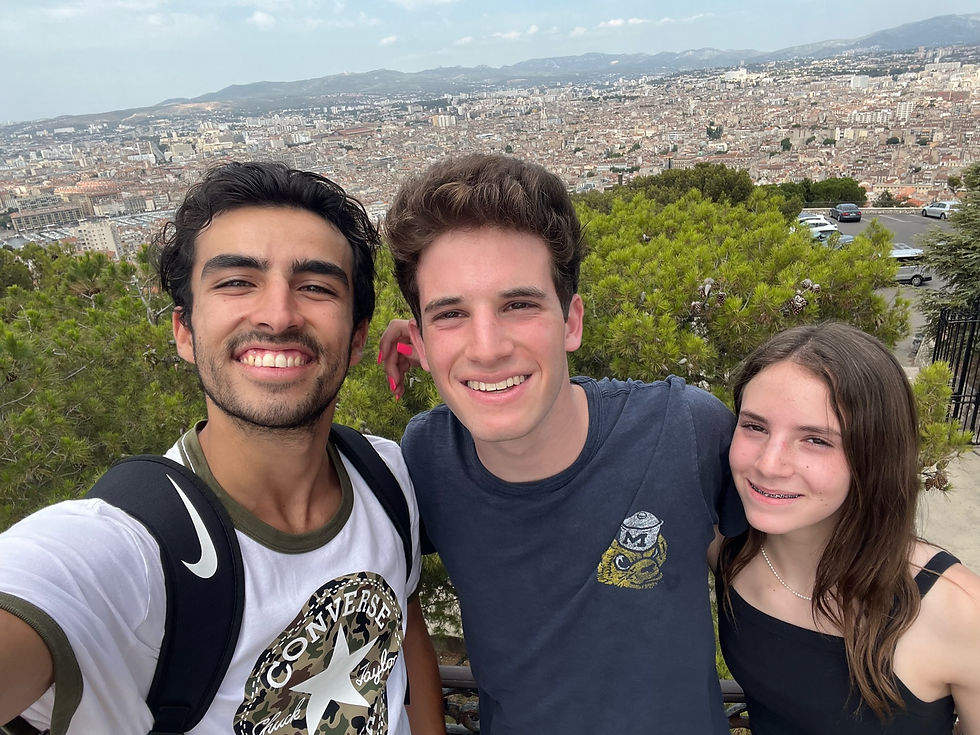Just another Week in Paris
- Ian Rosenberg

- Jun 16, 2022
- 4 min read
I’m back! In my sports and culture class on Monday, we went to Jardin du Luxembourg—a large garden in the Latin Quarter that houses the senate. We walked around, talking about the connection between native sports and local identities, before trying our hand at a traditional French sport, pétanque.
Pétanque is like Bocce, really. You play on a pit of dust, sand, gravel, and rocks, and break up into two teams. Our professor explained that it’s a game you can play with as few as two people, and at any age. One person starts by throwing a small ball, called the cochonnet (little pig). Then, the teams try to throw their metal balls as close to the cochonnet as they can. You don’t alternate turns, but instead, the team that does not have the closest ball to the center will keep on throwing until they either get one closer than the other team’s closest, or run out of their three balls. The strategy comes in when you realize that what’s on the field is indeed movable, including the cochonnet! There’s also strategy in that the more arced and with spin you throw the ball, the less it will move once hitting the ground, but it’s harder to aim when you do that. It also doesn’t help that an aspect of the game is that the ground isn’t necessarily flat. Here’s some pictures from our time playing!

Nothing much else went on that day. On Tuesday, I went with a friend to the Arts et Métiers Museum, which is a museum that holds historical scientific objects. It was a super cool place, especially for the engineers on the trip! The museum was split into many different sections, first was scientific instruments, such as microscopes, Lavoisier’s set-up for demonstrating the conservation of matter in chemical reactions, weights and measures, a particle accelerator, and lots of clocks. There were also communications tools, such as typewriters, moveable type, radios, and telegrams; there were models of bridges and buildings’ domes around Paris, along with a section on just “mechanics” that was filled with all sorts of wacky setups of gears and bearings. What was most exciting for my friend and I was the “power” section though, because it was filled with engines! We’ve spent many, many classes of thermodynamics studying engines, and the cycles that we studied—Diesel, Lenioir, and Ericsson just to name a few—were all represented in the museum…
That night, about half our thermo class went out for dinner together in China Town, and we ate under the aegis of a 100-point space invader!

Top left: my friend and I excited to see engines. Top right: me holding my exercise about the Lenoir Cycle in front of a Lenoir engine. Bottom: (after) dinner in Chinatown, the 100 point space invader in the top left corner
Wednesday morning was a bit of a bust. I tried to finish off a museum that I had started a few days before, but the section I wanted to see was closed again :( After my first class, I headed to the library to work on a presentation that I had the next day for Sports and Culture. The idea was to read one of the required or supplementary articles on the syllabus, and then present about it. One of the articles that stood out to me (of course, as a naval architecture major) was about Polynesian outriggers. French Polynesia—made of the famous islands of Bora Bora and Tahiti, among others—is still very much a part of France proper, in a similar way as to how Guam is a part of the US. In fact, the 2024 Paris Olympics are hosting the surfing events in Tahiti—nearly 10,000 miles away! But there is a sport there called Va’a, or pirogue in French, which is the tradition of racing these outrigger canoes between islands. And yes, that means in the terrifyingly deep blue ocean between those islands. That’s what this article was about. Actually, the article on the syllabus I had trouble finding online, so I found a similar one that was in French. I worked my way through the 15-page document, and I feel like the challenge of reading in a different language actually made me more able to retain info than otherwise! It was a really interesting topic, and I really enjoyed learning all about this tradition. What I found super intriguing was that there’s this Frenchman, Yves Haupert, who, after coming to French Polynesia for a journalism project, quickly fell in love with Pirogue. He’s considered the first non-Polynesian to be able to take on the difficult task of the Hawaiki Nui Va’a (the pirogue competition since the early ‘90s), and he did it for five years in a row. The Tahitian people quickly welcomed him into their society and he’s still there to this day.
Wednesday night was spent by the Eiffel Tower. Usually our Eiffel Tower Picnics and Light Show Watch Parties have about five people, but we went all out this week. At its height, we had over twenty friends sitting on the Champ de Mars enjoying a selection of French breads, charcuteries, wines, and cheeses. It was a lot of fun!
Thursday wasn’t anything too special. I went to the Jewish Quarter and had lunch in the courtyard of the National Archives (very close to the school), I did try escargots for the first time (and they were quite good!), and after dinner, I went rock climbing with some friends to end out the day. That’s about all I have for now, so I suppose, à plus! (Later!)
Escargots

Rock Climbing!










Comments